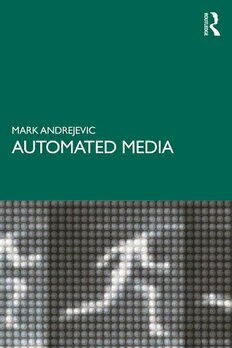
Automated Media PDF
Preview Automated Media
Automated Media In this era of pervasiveautomation, Mark Andrejevic provides an original framework for tracing the logical trajectoryof automated media and their social, political, and cultural consequences. This book explores the cascading logic of automation, which develops from the information collection process through to data processing and, finally, automated decision-making. It argues that pervasive digital mon- itoring combines with algorithmic decision-making and machine learning to create new forms of power and control that pose challenges to demo- cratic forms of accountability and individual autonomy alike. Andrejevic providesanoverviewoftheimplicationsofthesedevelopmentsforthefate of human experience, describing the “bias of automation” through the logics of pre-emption, operationalism, and “framelessness.” Automated Media is a fascinating and groundbreaking new volume: a must-read for students and researchers of critical media studies interested in the intersections of media, technology, and the digital economy. Mark Andrejevic is Professor of Media Studies at Monash University, where he heads the Automated Society Working Group in the School of Media,FilmandJournalism.HeistheauthorofInfoglut:HowTooMuch Information is Changing the Way We Think and Know, iSpy: Surveillance and Power in the Interactive Era; and Reality TV: The Work of Being Watched, as well as numerous journal articles and book chapters on sur- veillance, popular culture, and digital media. Automated Media Mark Andrejevic Firstpublished2020 byRoutledge 52VanderbiltAvenue,NewYork,NY10017 andbyRoutledge 2ParkSquare,MiltonPark,Abingdon,OxonOX144RN RoutledgeisanimprintoftheTaylor&FrancisGroup,aninforma business ©2020Taylor&Francis TherightofMarkAndrejevictobeidentifiedasauthorofthisworkhas beenassertedbyhiminaccordancewithsections77and78ofthe Copyright,DesignsandPatentsAct1988. Allrightsreserved.Nopartofthisbookmaybereprintedor reproducedorutilisedinanyformorbyanyelectronic,mechanical,or othermeans,nowknownorhereafterinvented,includingphotocopying andrecording,orinanyinformationstorageorretrievalsystem, withoutpermissioninwritingfromthepublishers. Trademarknotice:Productorcorporatenamesmaybetrademarksor registeredtrademarks,andareusedonlyforidentificationand explanationwithoutintenttoinfringe. Chapter4includesargumentsthatwerefirstpresentedinAndrejevic, Mark(2017).“ToPre-EmptaThief.”InternationalJournalof Communication11(2017):879–91. LibraryofCongressCataloging-in-PublicationData Acatalogrecordforthistitlehasbeenrequested ISBN:978-0-367-19659-2(hbk) ISBN:978-0-367-19683-7(pbk) ISBN:978-0-429-24259-5(ebk) TypesetinTimesNewRoman byTaylor&FrancisBooks For mentors at four institutions: Janice Peck John Durham Peters Graeme Turner Arden Reed I have been so fortunate to benefit from your support and friendship. Thank you. Contents 1 The Subject of Automation 1 2 The Bias of Automation 25 3 Automated Culture 44 4 Pre-emption 73 5 The Operational City 94 6 Framelessness 113 7 Automating Desire 133 Index 168 1 The Subject of Automation Theinventor,futurist,andGoogleguruRayKurzweilhassecularfantasiesof immortalityand resurrection. Not onlydoeshe take “thousandsofdollars” ofvitaminsadaytohelphimliveuntilthetechnologyisavailabletoupload his consciousness into a machine (Blodget 2015), but he is collecting infor- mationabouthisdeceasedfathersohecanbereincarnatedintheformofan AI (artificial intelligence). Kurzweil imagines that some combination of archival material and machine learning will be able to construct a digital versionofhisfatherthathecanconversewith–perhapsforever–ifhesuc- ceeds in surviving until the “singularity” (when human and machine con- sciousness merge). Until then, he believes his paternal AI will be, for conversationalpurposes,notjustanaccuratereproduction ofhisfatherbut, asheputsit,“morelikemyfatherthanmyfatherwouldbe”(Berman2011). Atfirstglance,suchaformulationsoundslikelittlemorethanthehyperbole ofapracticedfuturist,albeitwithaninterestingpost-Oedipalpsychoanalytic twist.However,thereisalurkingpsychoanalyticinsightinthisformulation: thatthesubjectis,inanimportantsense,non-self-identical:thatis,thereare aspectsofthesubjectthatremainunavailabletoit.Theparadox,then,isthat a self-identical digital subject would not be like itself at all – it would be “more” coherent and fully specified than an actual subject. To say that a data-driven simulation might be “more like” someone than they are them- selves is to suggest that it would be more consistent, perhaps living up to some idealized image of the self that the subject itself was unable to attain. However, if a subject is, in important ways, constituted by its gaps and inconsistencies,theattemptto“perfect”itamountstoanattempttoobliter- ate it. That Kurzweilwould aspire to thisversionof perfection isunsurpris- ing, given his goal of achieving digital immortality by shedding the spatial andtemporallimitsofsubjectivity. Perhaps predictably, the promise of technological immortality is insepar- ablefromthatofautomation,whichofferstosupplanthumanlimitationsat everyturn.Whenitcomestothefateofthesubject,theformsofautomation at stake are not simply mechanical (as in the factory) but informational. Creating a digital model of individuals relies on automated forms of data collection and information processing facilitated by digital media
